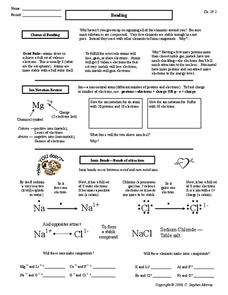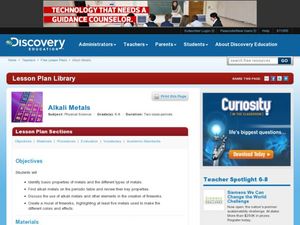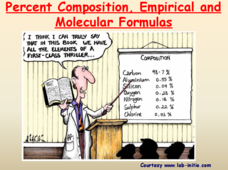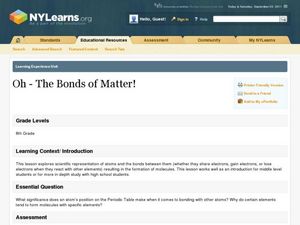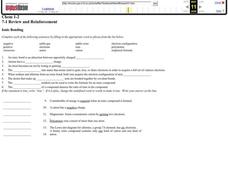Curated OER
Periodic Table & Its Trends
Students review atomic structure and then participate in a activity in which they categorize several "elements" into some form of order based on their properties. They discuss the trends they see. They also practice several electron...
Curated OER
Periodic Table
In this periodic table and elements learning exercise, students review valence electrons, octet rule, oxidation number, and the difference between metals and non-metals on the periodic table. This learning exercise has 5 matching, 20...
Curated OER
Bonding
In this bonding learning exercise, students read about the two different types of chemical bonding: ionic and covalent bonds. Students review ion notation and oxidation numbers. This learning exercise has 24 fill in the blank, 2...
Curated OER
Bonding
In this bonding worksheet, high schoolers read about the octet rule in bonding, ion notation, ionic bonds, covalent bonds and oxidation numbers. Students write 2 ion notations, they determine if 8 sets of ions will make compounds, they...
Curated OER
Alkali Metals
Middle schoolers explore the unique properties of alkali metals. For this chemistry lesson, students create a mural of fireworks display after researching its different element components. They write a brief description about an alkali...
Curated OER
Reading Chemical Formulas
Students interpret basic chemical formulas. When class begins, students interpret a "chemical formula" for fruit salad. After they interpret the recipe, students use the same strategies to identify chemical formulas. They evaluate the...
Curated OER
Oxidation/Reduction Reactions
In this chemical reactions worksheet, students review the oxidation number rules and then assign oxidation numbers to atoms in given compounds. Students identify the reducing agent and the oxidizing agent in reactions. Students practice...
Curated OER
Chemical Bonding and Shapes of Molecules
In this chemical bonds worksheet, students review the different types of bonds, Lewis dot structures, ions, and molecule shapes. This worksheet has 10 matching, 17 multiple choice, and 3 drawing questions.
Curated OER
More Chemical Bonding
In this chemical bonding worksheet, students review the three types of compounds: ionic, covalent, and polyatomic. Students practice drawing the covalent bonds of given compounds. This worksheet has 5 drawings and 13 fill in the blank...
Curated OER
More Chemical Bonding
In this chemical bonding worksheet, high schoolers review the three types of bonds including ionic, covalent and polyatomic compounds. They identify 8 compounds as ionic, covalent or polyatomic and they make 4 ionic compounds and they...
Curated OER
pH Scale, acids and bases
Eighth graders define the pH scale, acids and bases. They distinguish between acidic and basic solutions using litmus paper. Students review simple chemical formulas. They define the subscript and coefficient in terms of chemical...
Curated OER
Naming III-Identifying Problems Chemical Compound Names
In this naming chemical compounds learning exercise, students are given 9 lettered statements that they use to match with 10 statements about compounds. Students also review the rules for naming compounds by filling in 25 blanks to...
Curated OER
The Spectrum of a Star
Tenth graders identify stars based on their line spectra. In this astronomy lesson, 10th graders analyze spectrograph and determine the elements present in the star. They explain the relationship between temperature and star classes.
Curated OER
Stoichiometry
In this stoichiometry activity, students review definitions and equations associated with molarity, density, atomic mass, molarity, and dilutions. This activity has 18 word problems.
Curated OER
Ionic Compounds
In this compounds worksheet, students review the structure and properties of ionic compounds, their formulas and nomenclature, and molecular mass and percentage composition. This worksheet has 4 short answer questions and 7 problems to...
Curated OER
Physics and the Quantum Mechanical Model
For this physics worksheet, students review vocabulary terms and key equations associated with the quantum mechanical model. Students apply the quantum theory to explain the photoelectric effect. This worksheet has 5 true or false, 12...
Science Geek
Percent Composition, Empirical and Molecular Formulas
Help your pupils understand when empirical becomes molecular. The lesson presentation demonstrates the connection between empirical formulas and molecular formulas. Then, given percent composition, the lesson demonstrates the steps to...
Curated OER
Oh - The Bonds of Matter!
Eighth graders identify the types of bonds elements form. In this chemistry lesson, 8th graders represent valence electrons with dot structures. They draw and label different atoms.
Curated OER
Understanding Oxidation Numbers
Students review atomic numbers, positive and negative charges, and the periodic table. They examine the relationships among protons and electrons, location of various elements, electron energy levels, and oxidation numbers.
Curated OER
Isotopes
In this isotopes activity, learners review mass number, molecular notation, electron attraction, and electron orbits. This activity has 5 matching and 5 short answer questions.
Curated OER
Chemical Bonding
In this chemical compounds worksheet, high schoolers review the different types of bonding, define the octet rule, and draw Lewis structures (electron-dot diagrams) for given compounds. This worksheet has 7 fill in the blank, 5 short...
Curated OER
Fats
In this fats worksheet, students review what fats are made up of, where fats come from, and how our body uses fats. Then students access a website to compare good fats and bad fats. This worksheet has 1 graphic organizer, 13 short answer...
Curated OER
Ionic Bonding
In this ionic bonding worksheet, students review the characteristics of ionic bonding, draw Lewis dot diagrams for elements, and write the chemical formula for ionic compounds. This worksheet has 8 drawings, 14 fill in the blank, and 6...
Curated OER
Chemistry Unit on Compounds, Formulas, and Equations
Students perform a review assignment in 3 portions to review chemistry compounds, formulas, and equations. The assignment consists of several different portions that can be used as assessments. The majority of the lesson plan is composed...




